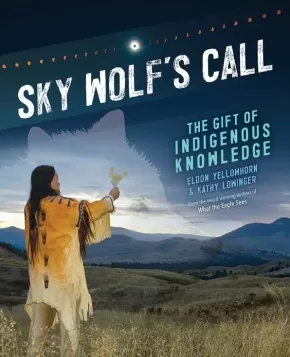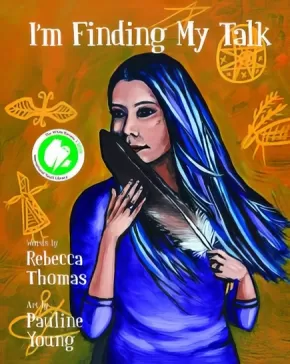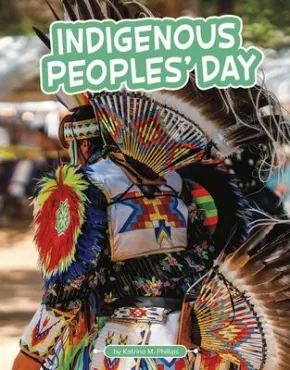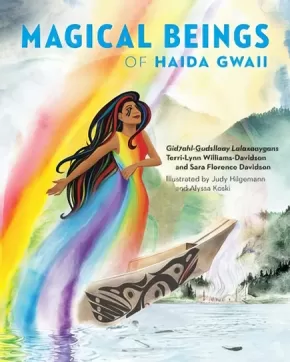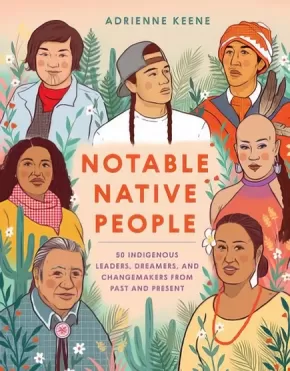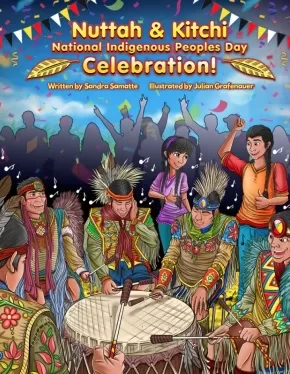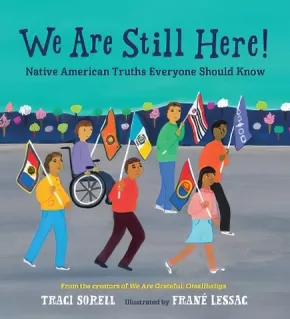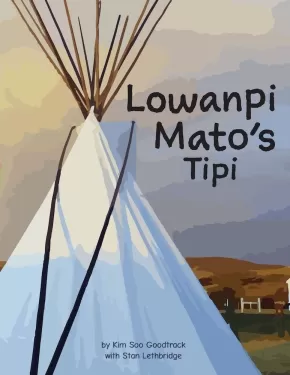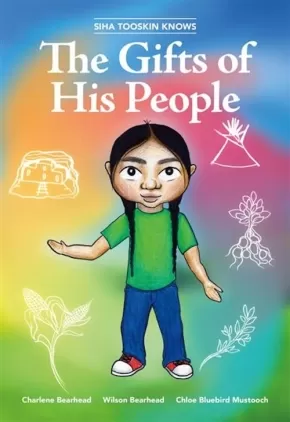
Indigenous Culture / Identity
16
-
30
of
56 Results;
Sort By
Go To
of 4
Sky Wolf's Call: The Gift of Indigenous Knowledge
$16.95
Format:
Paperback
Text Content Territories:
Indigenous Canadian; Indigenous American;
ISBN / Barcode: 9781773216294
Synopsis:
Synopsis:
From healing to astronomy to our connection to the natural world, the lessons from Indigenous knowledge inform our learning and practices today.
How do knowledge systems get passed down over generations? Through the knowledge inherited from their Elders and ancestors, Indigenous Peoples throughout North America have observed, practiced, experimented, and interacted with plants, animals, the sky, and the waters over millennia. Knowledge keepers have shared their wisdom with younger people through oral history, stories, ceremonies, and records that took many forms.
In Sky Wolf’s Call, award-winning author team of Eldon Yellowhorn and Kathy Lowinger reveal how Indigenous knowledge comes from centuries of practices, experiences, and ideas gathered by people who have a long history with the natural world. Indigenous knowledge is explored through the use of fire and water, the acquisition of food, the study of astronomy, and healing practices.
Reviews
"An authoritative tribute to Indigenous knowledge systems that's a must-have for every library and classroom." - Kirkus Reviews
“Sky Wolf’s Call has an astoundingly broad scope introducing Indigenous Traditional Ecological Knowledge (TEK) in North America from time immemorial to the current day … This fast paced celebration of Indigenous innovation and technology is riveting.” - The British Columbia Review
Educator Information
Interest Age: 11+
Grade: 6+
Reading Age: 11+
A Junior Library Guild Gold Standard Selection
Table of Contents
Author’s Note
1: Sky Wolf’s Call: The Gift of Indigenous Knowledge: Foundational ideas behind Indigenous Knowledge and the importance of retaining, maintaining, and learning this sacred knowledge.
2: Water Knowledge Ways: Water links us all and is sacred. Indigenous people have fought to protect the gift of water from harm, and the critical role it has played in transportation, agriculture, irrigation, and food.
3: Fire and Smoke Knowledge: Fire and smoke are great gifts, including the burning of tobacco. In sacred ceremonies, smoke connects our breath with the heavens. Fire cooks our food, helps grow our crops, and even keeps our waters clean. Cultural burns are used to benefit the land.
4: Indigenous Knowledge and Food Security: Sharing, growing, and receiving food with family, community, and visitors is both an honour and a tradition. By understanding the traditional practices of salmon fishing, clam gardens, planting and harvesting certain crops, or hunting buffalo, Indigenous Peoples have respected what Mother Earth has to offer.
5: Healing Knowledge Ways: The use of the medicine wheel and the sweat lodge have been used over centuries and still help sick and troubled people. Games such as lacrosse and chunkey have helped in building individual strength and community spirit. And braiding together Indigenous healing and western science has opened new learning opportunities.
6: Sky Knowledge: From the earliest Indigenous astronomers to modern astrophysicists, these sky watchers have studied the sacred gifts of the sky: the sun, moon, planets, and stars that have produced maps, calendars, beliefs about how to govern, and even directions for building homes.
7: Keeping the Knowledge: Indigenous People hold oral narratives in high esteem because that was the way knowledge passed from one generation to the next. People in North America recorded important events with symbols, pictographs (paintings), and petroglyphs (carvings). Language Keepers and Knowledge keepers are making sure that Indigenous knowledge is never forgotten.
8: Sky Wolf’s Call: Indigenous knowledge is based on the idea that this world is a gift. Understanding the idea of connections (the skies with the earth, people with animals, the practical with the spiritual) is an important lesson with the challenges of climate change, pandemics, and wars. The wisdom of Indigenous Knowledge can help the whole world.
Thanks and Acknowledgments
Glossary
Selected Reading
Sources and Contacts
Additional Information
120 pages | 7.50" x 9.25" | Paperback
Everything You Wanted to Know About Indians But Were Afraid to Ask: Young Readers Edition (HC) (4 in Stock)
$28.99
Format:
Hardcover
Text Content Territories:
Indigenous American; Native American;
ISBN / Barcode: 9781646140459
Synopsis:
Synopsis:
From the acclaimed Ojibwe author and professor Anton Treuer comes an essential book of questions and answers for Native and non-Native young readers alike. Ranging from "Why is there such a fuss about nonnative people wearing Indian costumes for Halloween?" to "Why is it called a 'traditional Indian fry bread taco'?" to "What's it like for natives who don't look native?" to "Why are Indians so often imagined rather than understood?", and beyond, Everything You Wanted to Know About Indians But Were Afraid to Ask (Young Readers Edition) does exactly what its title says for young readers, in a style consistently thoughtful, personal, and engaging.
Updated and expanded to include:
• Dozens of New Questions and New Sections—including a social activism section that explores the Dakota Access Pipeline, racism, identity, politics, and more!
• Over 50 new Photos
• Adapted text for broad appeal
Educator Information
Recommended for ages 9 to 12.
This book has a Native American/US focus.
Additional Information
400 pages | 1.11" x 1.11"
I'm Finding My Talk (PB)
$13.95
Artists:
Format:
Paperback
Text Content Territories:
Indigenous Canadian; First Nations; Mi'kmaq;
ISBN / Barcode: 9781774710067
Synopsis:
Synopsis:
I'm finding my talk
And it may take some time,
But I'm learning to speak
In a language that's mine.
A response to Rita Joe's iconic poem "I Lost My Talk," and published simultaneously with the new children's book edition illustrated by Pauline Young, comes a companion picture book by award-winning spoken-word artist and Mi'kmaw activist Rebecca Thomas. A second-generation residential school survivor, Thomas writes this response poem openly and honestly, reflecting on the process of working through the destructive effects of colonialism.
From sewing regalia to dancing at powow to learning traditional language, I'm Finding My Talk is about rediscovering her community, and finding culture. Features stunning, vibrant illustrations by Mi'kmaw artist Pauline Young.
Reviews
"Published as a companion to the picture book I Lost My Talk, featuring the famous poem by Rita Joe, both volumes explore the legacy of Canada’s residential schools. They feature vibrant illustrations by Pauline Young that bring the words alive with emotional nuance. This remarkable pair of books possesses the rare ability of being suited to readers of all ages: three to six-year-olds, the traditional intended audience of picture books, will be captivated by the bright, lively illustrations; elementary and middle school children will find their Social Studies curriculum enriched by experiencing these important concepts rendered creatively; teens and adults will gain insight and empathy by enjoying these beautiful poems." - CM Reviews
"[A]n honest reflection on the process of working through the destructive effects of colonialism by participating in cultural connections. This book offers the opportunity to show the journey one takes when rediscovering their community and culture." - The Dalai Lama Center
Educator Information
Recommended for ages 4 to 9.
Recommended in the Canadian Indigenous Books for Schools 2020/2021 resource list for grades 1-3 in the areas of Social Studies and Language Arts.
Former Halifax Poet Laureate and second-generation residential school survivor Rebecca Thomas writes honestly and powerfully in this companion piece to Rita Joe's I Lost My Talk. Includes vibrant illustrations from Mi'kmaw artist Pauline Young.
Additional Information
32 pages | 8.00" x 10.00"
Indigenous Peoples' Day
$11.99
Format:
Paperback
Text Content Territories:
Indigenous American;
ISBN / Barcode: 9781663926340
Synopsis:
Synopsis:
Indigenous Peoples' Day is about celebrating! The second Monday in October is a day to honor Native American people, their histories, and cultures. People mark the day with food, dancing, and songs. Readers will discover how a shared holiday can have multiple traditions and be celebrated in all sorts of ways.
Awards
- 2022 American Indian Library Association winner
Educator Information
Recommended for ages 5 to 8.
This book is about Indigenous Peoples' Day in the United States.
Additional Information
32 pages | 7.00" x 9.00" | Paperback
Magical Beings of Haida Gwaii (PB)
$14.95
Format:
Paperback
Text Content Territories:
Indigenous Canadian; First Nations; Haida;
ISBN / Barcode: 9781772033700
Synopsis:
Synopsis:
Based on ancient Haida narratives, this vibrantly illustrated children's book empowers young people and teaches them to live in harmony with nature.
Haida Gwaii is home to a rich and vibrant culture whose origins date back thousands of years. Today, the Haida People are known throughout Canada and the world for their artistic achievements, their commitment to social justice and environmental protection, and their deep connection to the natural world. Embedded in Haida culture and drawn from ancient oral narratives are a number of Supernatural Beings, many of them female, who embody these connections to the land, the sea, and the sky. Magical Beings of Haida Gwaii features ten of these ancient figures and presents them to children as visually engaging, empowering, and meaningful examples of living in balance with nature. Developed by renowned Haida activist, lawyer, performer, and artist Terri-Lynn Williams-Davidson and Haida educator Sara Florence Davidson, this book challenges stereotypes, helps advance reconciliation, and celebrates Indigenous identity and culture.
Reviews
"Magical Beings of Haida Gwaii is a gentle, powerful collection of words and pictures, stories that hold knowledge, teachings, and traditions for the generations of today and the future. A must-read for those who live on the beautiful island of Haida Gwaii, and any Canadian who wants to learn about one of the many vital Indigenous cultures across Turtle Island." — David A. Robertson, winner of the Governor General’s award for When We Were Alone
"Magical Beings of Haida Gwaii is an enchanting book born of a close relationship and understanding of how we see the world from an Indigenous perspective. There is an intrinsic value to stories recorded from the most natural of primary sources, our families. Terri-Lynn and Sara Davidson have given us a lesson on how to value our Indigenous magical beings as we all have them."— Naa-Jing-Jada, Verna J. Kirkness, educator and author of Creating Space: My Life and Work in Indigenous Education
"An absolute treasure and honouring for the Haida People and for Haida Gwaii, and a marvel of devotion for the world to learn from. Oh I love this book so much! I am in awe of Magical Beings of Haida Gwaii. Every Nation deserves a book as gorgeous and as healing as this one." — Richard Van Camp, award-winning author of Moccasin Square Gardens
Educator Information
Recommended for ages 5 to 8.
Recommended in the Canadian Indigenous Books for Schools 2020/2021 resource list for grades 2 to 9 for English Language Arts, Fine Arts, and Social Studies.
Includes a glossary and pronunciation guide at the back.
A Colouring and Activity Book for this work can be found here: Magical Beings of Haida Gwaii Colouring and Activity Book
Additional Information
64 pages | 8.00" x 10.00" | Paperback
Notable Native People: 50 Indigenous Leaders, Dreamers, and Changemakers from Past and Present
$24.99
Artists:
Format:
Hardcover
Text Content Territories:
Indigenous American; Alaska Native; Native American; Indigenous Hawaiian;
ISBN / Barcode: 9781984857941
Synopsis:
Synopsis:
An accessible and educational illustrated book profiling 50 notable American Indian, Alaska Native, and Native Hawaiian people, from NBA star Kyrie Irving of the Standing Rock Lakota to Wilma Mankiller, the first female principal chief of the Cherokee Nation
Celebrate the lives, stories, and contributions of Indigenous artists, activists, scientists, athletes, and other changemakers in this beautifully illustrated collection. From luminaries of the past, like nineteenth-century sculptor Edmonia Lewis—the first Black and Native American female artist to achieve international fame—to contemporary figures like linguist jessie little doe baird, who revived the Wampanoag language, Notable Native People highlights the vital impact Indigenous dreamers and leaders have made on the world.
This powerful and informative collection also offers accessible primers on important Indigenous issues, from the legacy of colonialism and cultural appropriation to food sovereignty, land and water rights, and more. An indispensable read for people of all backgrounds seeking to learn about Native American heritage, histories, and cultures, Notable Native People will educate and inspire readers of all ages.
Additional Information
144 pages | 7.26" x 9.29" | Hardcover
Nuttah & Kitchi National Indigenous Peoples Day Celebration
$14.99
Artists:
Format:
Paperback
Text Content Territories:
Indigenous Canadian; First Nations; Inuit; Métis;
ISBN / Barcode: 9780993937194
Synopsis:
Synopsis:
Nuttah and Kitchi National Indigenous Peoples Day Celebration is written by Sandra Samatte, Ojibwe - Saulteaux - from Skownan First Nation Treaty 2 Territory and illustrated by Julian Grafenauer, Ojibwe from Rolling River First Nation.
Come celebrate and explore with Nuttah and Kitchi on June 21st, the first day of summer as they experience all the exciting fun-filled activities and events that take place on National Indigenous Peoples Day.
Educator Information
Recommended for grades 2 to 5.
A companion activity book is available: Nuttah & Kitchi National Indigenous Peoples Day Celebration Activity Book: Indigenous Teachings and Fun Activities for Everyone
Additional Information
32 Pages | Paperback
Nuttah & Kitchi National Indigenous Peoples Day Celebration Activity Book
$9.95
Artists:
Format:
Paperback
Text Content Territories:
Indigenous Canadian; First Nations; Inuit; Métis;
ISBN / Barcode: 9781990297007
Synopsis:
Synopsis:
Companion book to Nuttah and Kitchi National Indigenous Peoples Day Celebration, featuring Indigenous Teachings and Fun Activities for Everyone!
Both resources are written by Sandra Samatte, Ojibwe - Saulteaux - from Skownan First Nation Treaty 2 Territory and illustrated by Julian Grafenauer, Ojibwe from Rolling River First Nation. Come celebrate and explore with Nuttah and Kitchi on June 21st, the first day of summer as they experience all the exciting fun-filled activities and events that take place on National Indigenous Peoples Day.
Educator Information
Recommended for grades 2 to 5.
Find the companion book here: Nuttah & Kitchi National Indigenous Peoples Day Celebration
Additional Information
32 Pages | Paperback
This Is What I've Been Told
$16.99
Artists:
Format:
Paperback
Text Content Territories:
Indigenous Canadian; First Nations; Anishinaabeg; Ojibway;
ISBN / Barcode: 9781989122693
Synopsis:
Synopsis:
Knowing our culture means knowing who we are. When we know who we are, we can walk in a good way.
It's been said when teachings are passed down from one generation to the next, good things can happen. Language is learned, knowledge is shared and culture is practiced. In this story of language preservation, author/illustrator and Anishnaabemowin language teacher Juliana Armstrong illuminates a number of Anishnaabemowin words along with their cultural connections, passed down from her Ojibway ancestors. Knowing our culture means knowing who we are. When we know who we are, we can walk in a good way.
Educator Information
Recommended for ages 6 to 8
This book shares Anishnaabemowin words, their cultural connections and how to say them, with the help of phonetics.
A story of Indigenous language preservation and revitalization.
This authentic book is written and illustrated by an Ojibway artist and Anishnaabemowin language teacher.
A teacher lesson plan is available: This Is What I've Been Told Teacher Lesson Plan
This book is available in French: C'est ce qu'on m'a dit
Additional Information
40 pages | 11.00" x 8.50"
We Are Still Here!: Native American Truths Everyone Should Know
$21.99
Artists:
Format:
Hardcover
Text Content Territories:
Indigenous American; Native American;
ISBN / Barcode: 9781623541927
Synopsis:
Synopsis:
Twelve Native American kids present historical and contemporary laws, policies, struggles, and victories in Native life, each with a powerful refrain: We are still here!
Too often, Native American history is treated as a finished chapter instead of relevant and ongoing. This companion book to the award-winning We Are Grateful: Otsaliheliga offers readers everything they never learned in school about Native American people's past, present, and future. Precise, lyrical writing presents topics including: forced assimilation (such as boarding schools), land allotment and Native tribal reorganization, termination (the US government not recognizing tribes as nations), Native urban relocation (from reservations), self-determination (tribal self-empowerment), Native civil rights, the Indian Child Welfare Act (ICWA), religious freedom, economic development (including casino development), Native language revival efforts, cultural persistence, and nationhood.
Reviews
"Students at the Native Nations Community School share presentations about the history, present, and future of Indigenous communities. The vivid artwork features a simple, bold style. The narrative starts with a general introduction of Native Nations in the United States. Each presentation contains illustrations with the student’s name, an overview of the subject, a brief list of the impact that the concept or historical moment had on Native American people, and the refrain “We Are Still Here!” The last pages show students and their families with a variety of skin tones and physical abilities studying the presentations on topics that include sovereign rights and relocation. Additional information, a timeline, a glossary, sources, and an author’s note offer further context. The lyrical text and jewel-tone illustrations elegantly work together to stirringly portray the ongoing fight for Native American recognition and rights. VERDICT An essential purchase for introducing the impact laws and treaties had and continue to have on Native Nations." —School Library Journal, starred review
"In this meticulously researched nonfiction picture book, Sibert honorees Sorell and Lessac team up once again to answer this question: What has happened to Native Nations and their citizens after the treaties with the U.S. government ended in 1871? Lessac’s trademark colorful, folk-art–style illustrations show a Native American community school with a classroom of diverse students preparing for presentations at the Indigenous People’s Day assembly. Spread by spread, each child speaks, featured words and terms highlighting the journey Native Nations have taken to reclaim their land and rights. They show why Indigenous people say, “We are still here!” In the “Assimilation” presentation, Native children are dressed in militarylike uniforms, showing how U.S. leaders used schooling to destroy Native traditions. Dividing plots of tribal land for “Allottment” left much treaty land open for public sale. With “Termination” and “Relocation,” Native people were encouraged to leave their tribal lands and “act more like white people.” But Indigenous people say, “We are still here!” and the narrative arc turns to emphasize resilience. When activists speak up and organize, it strengthens tribal sovereignty. The tribes “protect and provide for future generations” by holding on to their traditional ceremonies, opening businesses to support their tribal members, and reviving their tribal languages. The illustrations, too, change their tenor, modulating from historical wrongs to emphasize contemporary strength, community, and joy. An emphatic, triumphant declaration: “WE ARE STILL HERE!”" —Kirkus Reviews, starred review
Educator Information
Recommended for ages 7 to 10.
This book has a Native American focus.
Additional Information
40 pages | 9.88" x 10.81"
Lowanpi Mato’s Tipi
 $18.50
$18.50

Artists:
Format:
Hardcover
Text Content Territories:
Indigenous Canadian; First Nations; Sioux; Lakota;
ISBN / Barcode: 9781771744751
Synopsis:
Synopsis:
“Hokahe! Welcome!”
Welcome to Wood Mountain, home of the Lakota People, in southern Saskatchewan. It is here that we meet Stan Lethbridge, whose ancestral name is Lowanpi Mato (Singing Bear).
Join Lowanpi Mato as he prepares to set up his summer Tipi. He shares with us Lakota life values and traditions, and how they connect to building and taking care of a Tipi. He teaches us that to build a Tipi you need many items; some are from natural sources and others are purchased from a store. Lowanpi Mato takes us through a step-by-step building process so that we can all learn how a Tipi is built.
The Lakota language is woven throughout the story. The Lakota counting chart on pages 30 and 31 invites you to learn to count and have some fun looking back through the book to find items that match each number.
Welcome to Wood Mountain, home of the Lakota People, in southern Saskatchewan. It is here that we meet Stan Lethbridge, whose ancestral name is Lowanpi Mato (Singing Bear).
Join Lowanpi Mato as he prepares to set up his summer Tipi. He shares with us Lakota life values and traditions, and how they connect to building and taking care of a Tipi. He teaches us that to build a Tipi you need many items; some are from natural sources and others are purchased from a store. Lowanpi Mato takes us through a step-by-step building process so that we can all learn how a Tipi is built.
The Lakota language is woven throughout the story. The Lakota counting chart on pages 30 and 31 invites you to learn to count and have some fun looking back through the book to find items that match each number.
Educator Information
Lakota language is woven throughout this story, as are the seven values of Lakota life.
Lakota language is woven throughout this story, as are the seven values of Lakota life.
Includes a counting chart from 1 to 20 in Lakota, as well as a search-and-find counting game.
Additional Information
32 pages | 8.5" x 11" | Hardcover | ISBN: 9781771744751
32 pages | 8.5" x 11" | Hardcover | ISBN: 9781771744751
Making a Whole Person: Traditional Inuit Education (2 in stock, Out of Print)
$22.95
Artists:
Format:
Hardcover
Text Content Territories:
Indigenous Canadian; Inuit;
ISBN / Barcode: 9781774502051
Synopsis:
Synopsis:
“Before schools were introduced to the Inuit, we were taught by our relatives.”
In this picture book, Monica Ittusardjuat shares how she learned knowledge and skills in a time before being taken to residential school. She describes how children learned through playing games, imitating grown-ups, and observing adults around them.
Educator & Series Information
Recommended for ages 7 to 9.
Inhabit Education Books is proud to introduce Qinuisaarniq (“resiliency”), a program created to educate Nunavummiut about the history and impacts of residential schools, policies of assimilation, and other colonial acts that affected the Canadian Arctic. This book is a part of that program.
Each resource in the program has been carefully written and reviewed to include level-appropriate opportunities for students to learn about colonial acts and policies that affected Inuit. Topics covered include the residential school system, relocations to settlements and the High Arctic, sled dog slaughters, the use of E and W numbers, and others. These acts and policies created long-lasting impacts on Inuit individuals and communities, which are still being felt today.
The resources in this program include personal interviews, testimony, and writing; non-fiction informational resources; and information about traditional Inuit practices.
This resource is included in the Canadian Indigenous Books for Schools 2020/2021 list as being useful for grades 2 to 4 for English Language Arts and Social Studies.
Additional Information
26 pages | 8.00" x 9.00"
Powwow: A Celebration through Song and Dance (HC) (5 in Stock)
$24.95
Format:
Hardcover
Text Content Territories:
Indigenous American; Indigenous Canadian;
ISBN / Barcode: 9781459812345
Synopsis:
Synopsis:
Feel the power of the powwow dance.
Powwow is a celebration of Indigenous song and dance. It’s a journey through the history of powwow culture in North America, from its origins in colonization, the Indian Act and the Wild West shows of the late 1800s to the thriving powwow culture of today. As a lifelong competitive powwow dancer, Karen Pheasant-Neganigwane is a guide to the protocols, regalia, songs, dances and even food you can find at powwows from coast to coast, as well as the important role they play in Indigenous culture and reconciliation.
Educator & Series Information
Recommended for ages 9 to 12.
Beginning with a historical look at the origins of the powwow and then moving on to what they look like today, this book is a practical guide to the songs, dances, regalia, culture, and food associated with different powwows across North America.
This book explores how powwow culture, and an understanding of its importance in Indigenous culture, can be a part of the narrative of reconciliation.
The author is a longtime competitive powwow dancer who has travelled to powwows across North America.
This book is part of the Orca Origins series that explores cultural celebrations throughout the world.
Keywords: powwow dance, Indigenous culture, reconciliation, history, ceremonial dance.
Recommended in the Canadian Indigenous Books for Schools 2020/2021 resource list for grades 4 to 8 for English Language Arts, Social Studies, and Dance.
Additional Information
88 pages | 7.50" x 9.00" | colour illustrations / photographs
Siha Tooskin Knows the Catcher of Dreams
$11.95
Format:
Paperback
Text Content Territories:
Indigenous Canadian; First Nations; Stoney-Nakoda (Nakota);
ISBN / Barcode: 9781553798323
Synopsis:
Synopsis:
Siha Tooskin (Paul) takes his expert bike riding to a whole new level to make sure he doesn't miss a thing. At home, Mugoshin (Grandmother) is creating a very special gift to protect the precious little one. Join Paul as he enjoys delicious bannock, imagines the future of a new baby sister, and listens to Mugoshin’s teachings about the catcher of dreams.
The Siha Tooskin Knows series uses vivid narratives and dazzling illustrations in contemporary settings to share stories about an 11-year-old Nakota boy.
Reviews
"Siha Tooskin Knows the Catcher of Dreams is one in a series of Siha Tooskin Knows books that follows the life of Siha Tooskin, a young Indigenous boy (who also has the English name Paul). In this book Siha Tooskin’s mother is about to give birth to another baby so Siha Tooskin’s grandparents come to stay with him. His grandmother begins to tell him the story of the dream catcher along with the importance of this often-commercialized object. I love the sense of family we get from this book and how much importance Siha Tooskin’s grandmother places on the family unit, especially in a time where many Indigenous families are still actively being destroyed by systemic inequalities. As a teacher, I appreciated the mention of the Truth and Reconciliation Commission and the way teachers are still learning how to accurately represent Indigenous peoples. The illustrations are beautiful (especially the full page ones) and the grade level for reading is somewhere around grades 3-5 but the content is also perfect for grades 7 & 8 history. Overall, a great read perfect for K-8 classrooms alike." — Alyssa Gray-Tyghter, NetGalley, November 2019
Educator & Series Information
The Siha Tooskin Knows series uses vivid narratives and dazzling illustrations in contemporary settings to share stories about an 11-year-old Nakota boy. Explore Nakota culture and traditions alongside Paul Wahasaypa and his community in this eight-book series.
Key Features:
- A coming-of-age story about a Nakota boy learning about his identity and developing a sense of cultural responsibility in a contemporary, urban setting. Also touches on issues of environmental ecology and bullying.
- Charlene Bearhead and Wilson Bearhead are both well-respected and accomplished educators and storytellers.
- A part of the Siha Tooskin Knows series with teachings that show an Indigenous community and family in a positive light.
- Nakota lessons aim for universality, informing both Indigenous and non-Indigenous readers.
- This book illustrates how traditional teachings can play a vital role in contemporary life.
- Dynamic illustrations by Nakota artist Chloe Bluebird Mustooch bring this story to life.
Recommended for ages 9 to 11. Early Chapter Books.
Recommended in the Canadian Indigenous Books for Schools 2020/2021 resource list for Grades 3 to 6 in the areas of English and Social Studies.
Subjects/Themes/Keywords: Dreamcatcher, Nakota, Family.
Includes a glossary for the Nakota terminology in the story. Words are written phonetically as Nakota is not a written language.
Additional Information
32 pages | 5.50" x 8.00"
Siha Tooskin Knows the Gifts of His People
$11.95
Format:
Paperback
Text Content Territories:
Indigenous Canadian; First Nations; Stoney-Nakoda (Nakota);
ISBN / Barcode: 9781553798347
Synopsis:
Synopsis:
Transportation, housing, agriculture, communications…there are so many modern conveniences. But are they really modern? Where did they really come from?
Paul Wahasaypa—Siha Tooskin—will learn about their origins and more on his walk home from school with Ade (his father). There’s so much to learn about the earliest forms of technology, travel, medicine, and food from right here on Turtle Island. Come along with Paul and Ade to hear all about the gifts of his people.
The Siha Tooskin Knows series uses vivid narratives and dazzling illustrations in contemporary settings to share stories about an 11-year-old Nakota boy.
Educator & Series Information
The Siha Tooskin Knows series uses vivid narratives and dazzling illustrations in contemporary settings to share stories about an 11-year-old Nakota boy. Explore Nakota culture and traditions alongside Paul Wahasaypa and his community in this eight-book series.
Key Features:
- A coming-of-age story about a Nakota boy learning about his identity and developing a sense of cultural responsibility in a contemporary, urban setting. Also touches on issues of environmental ecology and bullying.
- Charlene Bearhead and Wilson Bearhead are both well-respected and accomplished educators and storytellers.
- A part of the Siha Tooskin Knows series with teachings that show an Indigenous community and family in a positive light.
- Nakota lessons aim for universality, informing both Indigenous and non-Indigenous readers.
- This book illustrates how traditional teachings can play a vital role in contemporary life.
- Dynamic illustrations by Nakota artist Chloe Bluebird Mustooch bring this story to life.
Recommended for ages 9 to 11. Early Chapter Books.
This fictional story talks about the earliest forms of technology, travel, medicine, and food and could be used for social studies, explorations of Indigenous technology/history, etc.
Additional Information
24 pages | 5.50" x 8.00" | Colour Illustrations
Sort By
Go To
of 4

